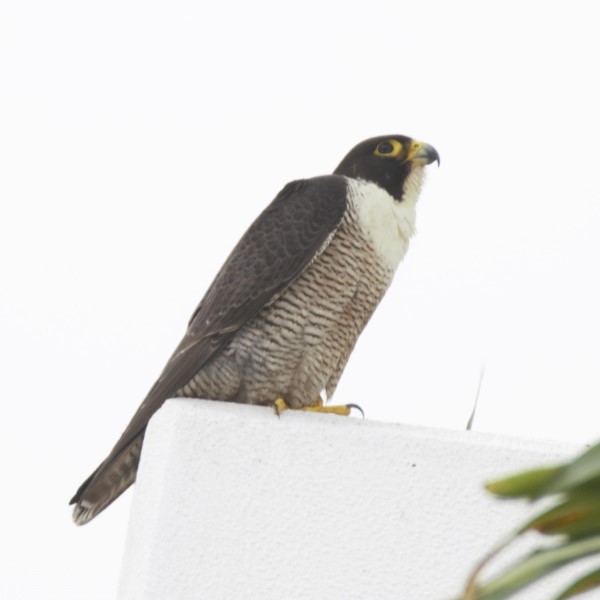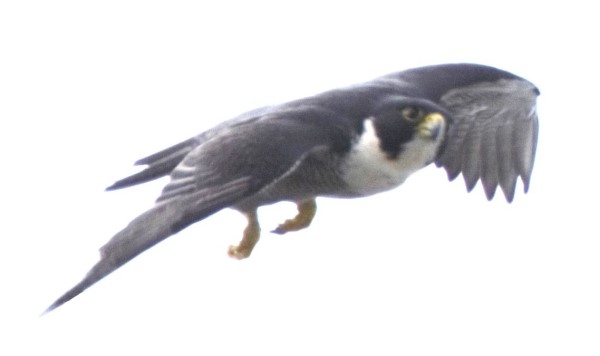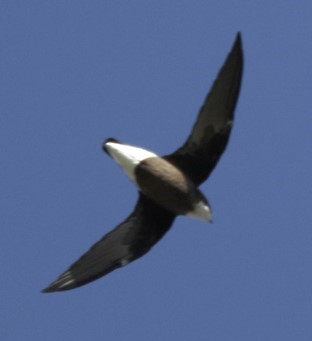Peregrine falcon
Common name: peregrine falcon
Scientific name: Falco peregrinus
Family: Falconidae
Peregrine falcons are not only the fastest bird in the world, reaching speeds of up to 180km per hour (some estimates even have them flying at much greater speeds) but they are also one of the most agile aerial hunters.

With its forward-facing eyes, glare-reducing black face, the ability to rapidly focus on an object while in flight and strong (full colour) binocular vision eight times better than our own, these birds can see their prey from a distance of more than three kilometres. Deep chest (pectoral) muscles power their finely tapered wings giving the peregrine both the aerial speed and manoeuvrability it needs to pursue and overtake other birds in flight. For catching its prey it is equipped with large feet and sharp talons (claws). And if the impact of being hit by a swooping falcon doesn't kill a bird instantly, it has a sharp, notched upper bill that can quickly sever a bird's spine.
To watch a peregrine falcon hunting - and catching its prey - is to see the result of millions of years of evolutionary fine-tuning driven by the need for a predator to catch its prey.
The peregrine falcon is listed as Least Concern in Queensland (Nature Conservation Act 1992).
Identification
Peregrines have a body length of 35-50 cm and an 80-105 cm wingspan, with the females being slightly larger than the males. They have a distinct, heavyset chest (big pectoral muscles for flight) and broad-based wings with each ending in a pointed tip.

The head and cheeks are covered in a black hood with yellow skin around the eye and on the cere (skin at base of beak covering nostrils). The chin and throat are white or yellowy-cream and the chest and under surface are flecked with black. The back and wings are slate-blue with darker barring (from underneath the wings and tail are tipped in black). The upper legs are covered in barred feathers while the lower legs and feet are yellow.
It flies with a series of shallow wing beats alternating with short glides, but will use deeper wing beats when hunting. Peregrines also soar on rising currents of warm air as an energy-efficient way of searching for prey.
Peregrines give a loud scream or "kee-kee-kee-kee" when communicating with their mate.
They are usually seen singly or in pairs (pairs stay together and form a life-long bond).
Similar species: Australian hobby Falco longipennis (smaller than the peregrine falcon with a light reddish-brown under surface. The black around its eyes doesn't extend far enough to form a hood).
Habitat and distribution
Peregrine falcons live in a wide variety of landscapes and vegetation types, occurring over much of the world. They have also adapted well to urban environments. In fact cities have become an important habitat for these birds, with skyscrapers mimicking the cliff faces that they often roost and nest on. Now, rather than watching wild birds from rocky outcrops, they roost on high-rise window ledges, eyeing well-fed pigeons as they take off from city parks.

New York is living proof of the importance of cities for peregrine falcons. It is now home to more pairs of peregrine falcon than any city in the world and has about 10 per cent of the total eastern USA's population.
In Queensland there are an estimated 950 breeding pairs of peregrine falcons with 25-35 pairs in south-east Queensland (six to ten pairs in the Greater Brisbane Region). Each pair requires a large home range, with pairs in south-east Queensland having an estimated range of 100 sq.km with a distance of 41 km between nest sites. A pair in the Moreton Bay area was recorded as having a range of 1500-2600 sq.km.
Falcons and DDT
Following World War II a new and persistent pesticide, DDT, came into widespread use in the control of agricultural and domestic insect pests. Many of the insects sprayed and killed with DDT were in turn eaten by other animals. Over time, the pesticide in their bodies 'bio-accumulated' as it moved through the food chain from insect through the insect-eating animals through to the larger predators. At higher concentrations it was found to cause the thinning of shells in the eggs of predatory birds like the peregrine falcon. Massive declines in peregrine populations occurred across the world and many local populations became extinct. In the USA, the peregrine falcon was listed as an endangered species in 1970 and the use of DDT was banned in 1972. DDT has now been banned globally to ensure further poisonings never occur. Even so, virtually every animal in the world now has some traces of DDT in its tissues. Fortunately, populations of these falcons and other birds of prey are now recovering.
The hunting falcon
Peregrine falcons usually catch their prey on the wing. Locating prey often begins while the falcon is soaring on a rising thermal of warm air. With its excellent vision and its ability to rapidly focus its eyes on objects while it is moving, it can easily see a bird the size of a pigeon from a distance of several kilometres.

When it finds a bird to hunt, it follows a curved flight path towards it. Studies have shown that a falcon sees objects in front of it most clearly when its head is turned at a 40 degree angle. However, in flight, a falcon cannot turn its head as it increases the aerodynamic drag by more than 50 per cent even at relatively slow speeds. Therefore it follows a curved path towards its prey, keeping its head straight and watching it with one eye. Even though a curved flight path is longer than a straight one, the curved approach proves to be quicker because there is less drag slowing the falcon down.
Closing in on its prey, the peregrine folds it wings and dives. Just before reaching its prey, the peregrine pulls out of the dive hitting it with open, sharply-clawed feet; often killing it on impact. If the prey survives this, it is quickly killed by a bite through the spine from the peregrine's notched beak.
Peregrines can also catch birds while in level flight or, more rarely, when taking off from a perch.
Once a bird is caught, it is plucked and eaten on the ground or moved to the safety of a roost or nest.
Who's faster: a peregrine or a swift?

There are few birds that could ever rival a peregrine falcon for speed. One is the white-throated needletail, also known as the spine-tailed swift. The needletail migrates from Southeast Asia in Spring and is a regular sight on cloudy summer days as it rides incoming storm fronts to feed on flying insects - often in loose flocks of hundreds of birds.
When watching needletails perform their aerial acrobatics it is hard to imagine another bird that can fly as fast. But the peregrine falcon can. In his book Australian Birds, wildlife artist and ornithologist, Peter Slater, writes about watching a peregrine falcon "playing" with needletails; easily catching up with one and then veering off to chase another.
Nesting
To prepare a nest site, peregrine falcons do little more than scrape a space big enough for their eggs. Peregrines prefer high cliff edges as nest sites or occasionally tree hollows or disused stick nests of other birds. Cliff edges provide safe locations and excellent vantage points to watch for prey. Peregrines also nest on artificial "cliffs" created by window ledges on high-rise buildings in the centres of cities.
Peregrines nest between August and November with females usually laying two to three eggs (rarely four). They have an incubation period of 33 days with the young emerging over two to three days. The young then spend another 39 days in the nest before they are fully fledged, but still remain dependent on parents until they learn their hunting skills. One brood was recorded as becoming independent when they were four to five months old.
The urban falcon
As city centres grow upward and outward they create the ideal framework for peregrine falcon habitat. Window ledges become roost and nest sites overlooking streetscapes and city parks full of hand-fed falcon-food in the form of pigeons.
As a result, city centres are now places where office workers and inner-city unit owners can see peregrine falcons flying past upper storey windows. In the central business district of Brisbane, there are now two nesting pairs of peregrine falcons (in 2001, New York City had four pairs nesting on buildings and eight on bridges).
With so many wild animals being driven out of our inner cities by development and human activity, the occasional sighting of a peregrine falcon is a welcome reminder that there will always be some part of nature nearby, no matter how artificial the environment becomes.
Related information
To watch falcons in other parts of Australia, here is one of the many websites you can visit:
Peregrine falcons at 367 Collins Street, Melbourne, Victoria